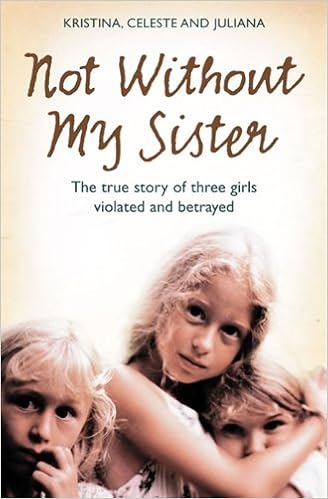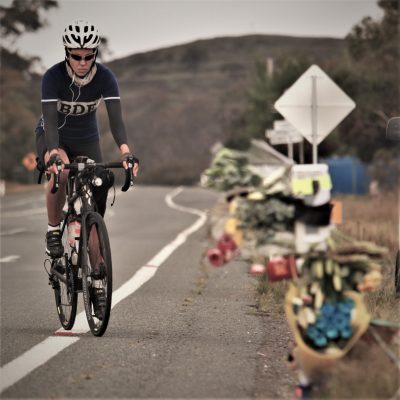 My wheels whistled in the hot crosswinds, and I gulped down a mouthful of water to moisten the dryness in my mouth and throat. I had set off from Ceduna, on the southern coast of Australia, in the freezing, pre-dawn darkness of late March 2017, with the target of reaching Port Augusta, nearly 300 miles across the state of Southern Australia, that night. I was racing in the inaugural 3,400-mile Indian Pacific Wheel Race and it had been an eventful race for me from the start: 750 miles in, I suffered a serious allergic reaction to the painkiller I had been taking for my bad knee, and had to go to a hospital.
My wheels whistled in the hot crosswinds, and I gulped down a mouthful of water to moisten the dryness in my mouth and throat. I had set off from Ceduna, on the southern coast of Australia, in the freezing, pre-dawn darkness of late March 2017, with the target of reaching Port Augusta, nearly 300 miles across the state of Southern Australia, that night. I was racing in the inaugural 3,400-mile Indian Pacific Wheel Race and it had been an eventful race for me from the start: 750 miles in, I suffered a serious allergic reaction to the painkiller I had been taking for my bad knee, and had to go to a hospital.
After getting the green light from the local doctor, I’d restarted the race again a week later with the intention of completing the course in an Individual Time Trial. On the morning of day six, a Facebook message lit up my phone screen: “OMG,” read a text from Billy Rice, a Tour Divide and Trans Am Bike Race veteran and cycling coach. Unable to type well while riding, I sent back a simple, “?”
“U haven’t heard about Mike yet? He got hit.”
“Shit. Serious?” I pulled up short on the side of the road.
“We think he died. Australians won’t confirm yet.”
“What???” For a moment I thought it must be a prank.
Mike’s GPS dot hadn’t moved since the incident, Billy told me. A report said he’d been rear-ended by a car. Mike’s status: “fatality.” It’s the word every family member and friend watching a rider’s tracker moving across a virtual map dread.
We all race knowing the risks we are taking—that anything can happen out there alone on the open road—but it is something we try not to dwell on much. The fear of all the “what ifs” would become paralyzing.
I rolled numbly along for a few more miles, in a state of shock and disbelief. Then it crashed into my gut like a sucker punch, knocking the air right out of my lungs, and I convulsed into hard sobs. It couldn’t be true. Not Mike. Mike was immortal. The strongest of us. A legend in the world of ultra cycling. He was my mentor and a kindred spirit. But most of all, he was my friend.
I first met Mike in December 2012, after returning from cycling around the world. He, too, had recently completed a record-breaking circumnavigation a few months before and we bonded over beers at a pub in Bristol, in the U.K., comparing notes and stories from the road until the bar called for final rounds. We hung out on weekend at the annual Bespoked Bike Show. We chatted about the loss of loves, the loneliness of the road, and the feeling of never quite being able to settle into a life of normalcy.
Mike had studied and worked as an engineer, but he struggled to conform to corporate life and the constrictions of a social structure he felt alien to. He seemed to wade hesitantly into humanity until he reached saturation point and couldn’t handle any more, then he would disappear. One night, we had been out drinking when, without warning, he took off running. I didn’t hear from him again until two days later. When Mike heard about the Mars One mission, he seriously considered applying for a one-way ticket off this planet. Riding a bicycle was his way of escaping from a world he did not walk through comfortably. On two wheels he was strong, he was more than human, he was his best self.
“He did it because he needed to,” Anna, his girlfriend of three years, said on a video chat to me a few days after his death. “After a race he would come back chilled and calm, contained, happy, relaxed for a few months. Then the need to do another would build and build till it reached a kind of fever pitch. Then he would become moody and difficult.” Pushing himself out on the road was not an option. It was a basic human need, like air.
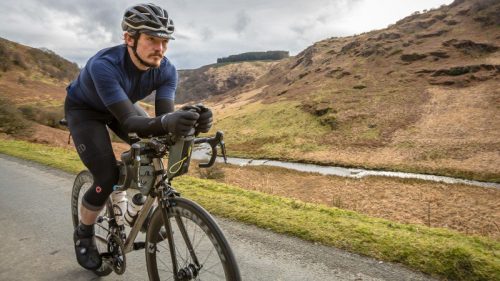
Somehow I got myself to the next little town in Australia before falling apart completely. My will to cycle had been totally knocked out of me. Until that moment, nothing could have made me quit the race. I was intent on reaching that finish line no matter what. Now none of it mattered. I was here because of Mike. My racing achievements, which include the Guinness World Record for being the fastest woman to circumnavigate the world on a bicycle, were all thanks to him. When Mike decided to put on the Transcontinental Race across Europe, from London to Istanbul, in 2013, it became the race that launched ultra, unsupported road racing into the mainstream and birthed a growing community of bikepacking “crazies” and their addicted following of “dot-watchers” around the world. Had he not gotten me into unsupported adventure racing I would not be here, somewhere in the middle of Australia. Likely none of us would be.
At the time that he started the Transcontinental Race in 2013 there were next to no women on the scene and Mike sent me an invite to the inaugural race saying, “We need women riders.” I had never raced in my life and had only been cycling a little over a year. “I don’t know if I am capable of it,” I told him.
“You’ve been around the world already, Europe will be a piece of cake. You just gotta ride your bike, the rest you already know.” He made it sound easy, like anybody could do it. Like I could do it. He gave me confidence. That was Mike. He wanted to get people riding, to encourage people to get out of their comfort zone and have an adventure. He constantly pushed me to explore my own capabilities and limits, to take it one step further. He was the bar that I wished to raise myself to.
“You don’t get called a badass without earning the title.” Mike told me when I had complained about the difficulty of the climbs crossing the high cols of the Alps during that first Transcontinental Race, the longest and most challenging of which was the highest, 15-mile-long, 9,045-foot-high, Stelvio pass in Italy. About halfway up, the sky had clouded over and rain started pelting down. Near the end, the wind turned ferocious. The higher I climbed, the worse the elements grew; wetter, colder, windier. The cold and wet soaked into muscle and bone, until it felt like I was freezing from the inside out. The race crew drove down from the summit checkpoint as I climbed the last miles in a blizzard. Mike was at the wheel, a camera guy next to him.
“This badass enough for you?” I shouted at him, my voice lost in the gale. He just smiled and shrugged without comment. My admiration for Mike quickly extended into a growing desire to earn his approval. Where others talked big, Mike quietly went ahead and did without making a big show. He did not seek out attention or recognition because he was not competing for anybody else, or any other reason than the pure joy of the ride.
I earned his validation the next year, during the inaugural 2014 Trans Am Bike Race, an unsupported 4,400-mile race, coast to coast across the U.S., from Oregon to Virginia. His advice to me as we lined up at the starting line in Astoria was, “Just don’t ever stop.” By the time I rolled up to the finish line I had suffered a cracked rib from a crash on the second day, a broken seat post that had destroyed my knees, numerous breakdowns, and a pinched nerve. Mike was waiting for me with a cold beer.
“I’m proud of you kid,” he said, hugging me. “That was a great ride.” For Mike, the real achievement lay in the struggle. Anybody could talk when the road was smooth. It was what you did when the going got tough that proved your mettle in the end.
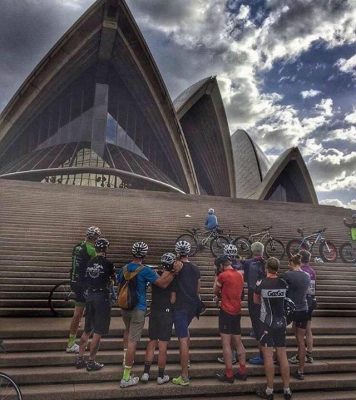
An hour after hearing about Mike’s accident, I was parked in front of a service station, crying. I sat paralyzed, unable to move or decide what to do next, when I got an update from the race organizers, saying they’d canceled the race. Riders were making their way to Sydney for a memorial tribute ride to Mike, scheduled for Sunday morning. I hitched a ride to Adelaide and caught a late Saturday night flight in to Sydney.
The street in Sydney was packed with hundreds of cyclists by 7:00 a.m. Only 11 of the 70 “Indy Pac” racers had managed to get there in time and we huddled together, overwhelmed after so much time alone on the road. We rode in silent procession to the Opera House, each absorbed in our own world of emotions. Kristof Allegart, the Belgian “terminator,” climbed the steps and left a bouquet of flowers. Then we stood, more than 500 strong, in silence. The silence stretched into minutes as we each said goodbye to the man who had inspired thousands around the world to ride their bikes.
Later our group of racers gathered in a nearby bicycle courier’s apartment for beers and memories. “What next?” seemed to be the question everyone asked each other. Some were going home, others would wait around for a few days to see other riders who were still coming in. Everybody spoke of Mike, his legacy, and what he meant to the world of unsupported ultracycling races.
To most he seemed like a legend, a machine that could go harder and further than everybody else—the embodiment of what cyclists aspired to be. Hashtags like #BeMoreMike were circulating, and he was already being set on that pedestal reserved for those immortalized by premature death. But to me, he was the understated, no-nonsense guy who, though often critical of others in the same field, was always quick to offer help and advice. The guy who could be churlish and introverted one moment, and a cheeky prankster the next.
One thing was clear, sipping my beer on the terrace, listening to the chatter around me. There would never be another Mike Hall, and it left me hovering over this empty space that he still filled, unable to come to terms with the fact that he was gone. In my mind, he was still out there on that empty stretch of road, a few hundred miles from the end of his final race. He would have hated leaving his race unfinished.
I needed closure, a way to say goodbye. Troy Bailey, a freelance photographer and journalist I’d met earlier in the day, was the last person to see Mike alive before that fated morning. Troy would be driving home to Melbourne in a day and offered to drop me there on the way. We agreed on a 5:00 a.m. start that Tuesday morning, and he pulled up early in his hollowed out van that functioned as a house-on-wheels and command center for his trips around the continent.
There had been a lot of speculation going around as to the cause of the crash and whose fault it was. Police were not releasing any statements. All we knew for sure was that at 6:25 a.m., on March 31, Mike had been rear-ended by a car and thrown from his bicycle. It appeared his death had been instant. I wanted to know what Mike’s state of mind had been before the crash. Had he been happy, at peace?
“When I caught up with him, he was just coming up on the second climb into Cabramurra and we actually stopped and had lunch,” Troy told me. “He was in really good spirits. I asked him what his thoughts were about trying to track Kristof down and Mike just kinda said, ‘Yeah, he got a way from me last night and I didn’t have it in me to chase him down, so I needed to have a rest.’ But he was totally fine and in a good place. His exact words were, ‘I don’t need to win this thing.'”
I asked Troy whether he thought sleep deprivation may have had something to do with the accident. “I don’t think so,” he said. “Mike had had a couple good nights’ rest. In fact he’d stopped a few hours that night.” This corroborated with what Anna had told me, that he had texted her at night, Australia time, to say he was stopping to sleep.
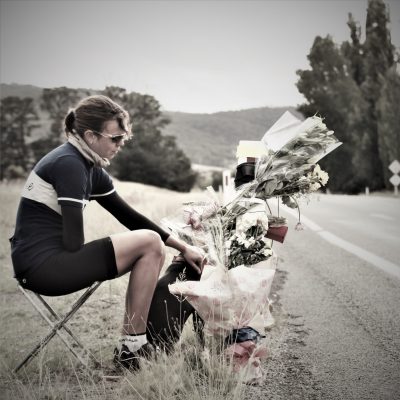 I spotted the crash site instantly from a distance. It was impossible to miss. The post that marked the place was so laden down with flowers, tires, reflective strips, energy gels, anything that passing cyclists could leave him, that it bowed halfway to the tarmac under the weight. The impact of Mike’s death across Australia and the world was undeniable. Thousands around the globe were dedicating rides in his honour.
I spotted the crash site instantly from a distance. It was impossible to miss. The post that marked the place was so laden down with flowers, tires, reflective strips, energy gels, anything that passing cyclists could leave him, that it bowed halfway to the tarmac under the weight. The impact of Mike’s death across Australia and the world was undeniable. Thousands around the globe were dedicating rides in his honour.
“It’s ironic that Mike felt so alone while he was alive,” Anna had said. “I don’t think he would believe how many people he affected through just doing what he did best, but I feel sad that it took his dying to get the recognition he was never given while he was alive.”
Troy pulled off the road near the crash site, and brought a little foldout picnic chair to leave for people to sit and have a chat with Mike. He passed me a marker to write a message on the post. The sky was cloudy. A chill wind prickled my skin, but I felt a stillness spreading like a warm blanket inside me. Looking down the highway ahead, I felt the familiar itch, the call of the open road. I could hear Mike saying, “You can’t take yourself too seriously. We’re just riding bikes.”
I smiled. “Then let’s ride.”

